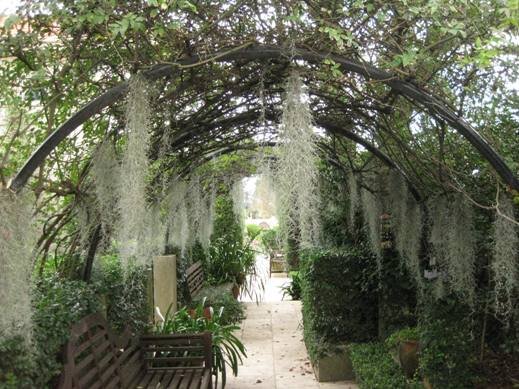Amazing plant @ctrl-alt-nwo! Spanish moss is neither from Spain nor a moss; it is an epiphytic member of the pineapple family from the Americas. Epiphytes are plants growing on other plants from which they derive no nutrients. Across its native range, from southeastern North America through Central and South America as far south as Argentina and Chile, it is a common sight draped over trees in high humidity areas. There is even evidence that the distribution of Tillandsia usneoides is correlated with the damage created by major storms. Carolus Linnaeus' use of the specific name, usneoides (Usnea-like), refers to the plant's superficial morphological and ecological similarity to the lichen genus Usnea, which is a symbiotic relationship between a blue-green alga and a fungus.


Tillandsia usneoides is rootless, consisting of narrow, alternate leaves arranged along a slender, wiry, silvery blue-green stem. Tillandsia usneoides lacks an extensive vascular system but is covered in tiny, water-absorbing scales; all the plant's water and nutrient needs are derived from rain, dust and detritus. Since Tillandsia usneoides gets all of its nutrients from the atmosphere it has been extensively investigated as a monitor for heavy metal pollution in urban areas.
In addition to morphological adaptations, Tillandsia usneoides shows a specific biochemical adaptation to growth in arid conditions, where water resources are likely to be limited; atmospheric carbon dioxide is fixed by a modification of photosynthesis called Crassulacean Acid Metabolism (CAM). In CAM photosynthesis, stomata (pores in plant surfaces) open at night; carbon dioxide enters the plant, where it is converted to organic acids. During the day, when the stomata are closed, the organic acids are transformed back to carbon dioxide and the normal machinery of photosynthesis converts carbon dioxide and water into sugars.


The biology of Tillandsia usneoides means it is a good disperser. Vegetative propagation occurs by stem fragments being carried by the wind or by birds; new plants readily growing from pieces trapped on trees or telegraph wires. The small, insect-pollinated flowers of Tillandsia usneoides have blue-green petals, but are frequently overlooked. When ripe fruit capsules open, small, flat, hairy, wind-dispersed seeds are released.
Human uses of this curious plant are limited. Stem fibres have been used by Native American cultures for weaving and rope-making, whilst whole plants, mixed with clay, have been used as daub, as medicine and even as animal fodder. Today, Tillandsia usneoides is most familiar as packing material or as a house plant.
A source: https://herbaria.plants.ox.ac.uk/bol/plants400/profiles/ST/Tillandsia